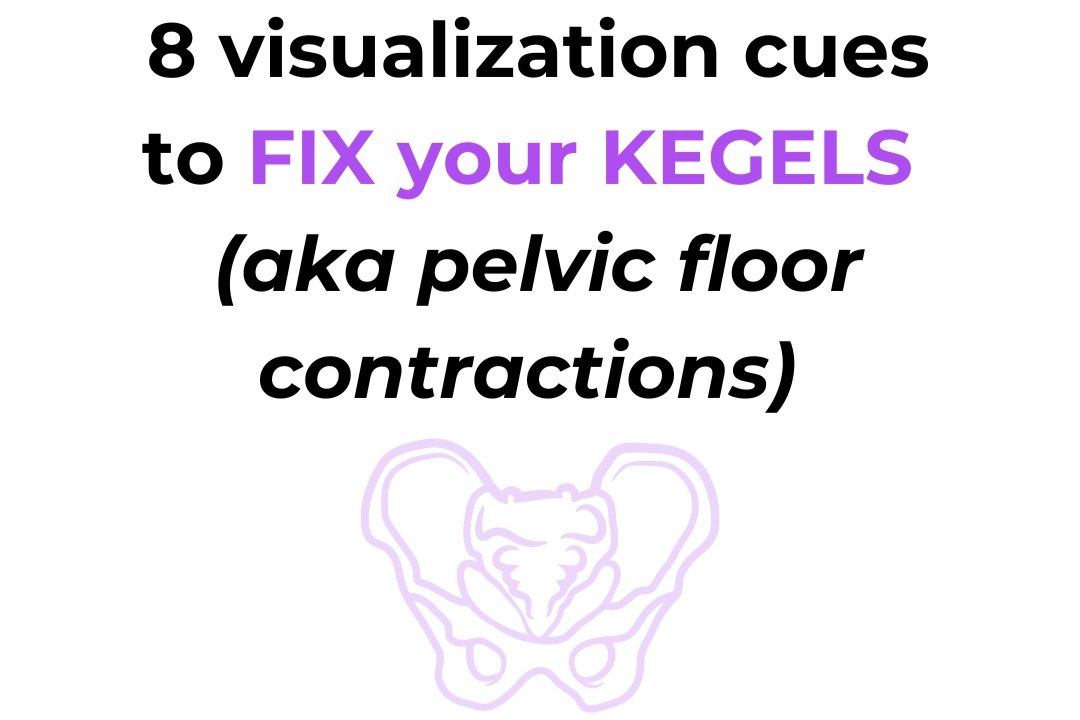Kegels and Reverse Kegels: your How-to Guide
We’ve often been told to “do your Kegels” for everything from leakage to postpartum recovery and pelvic pain. But what are Kegels in the first place? And does everyone need to do them?
What is a Kegel?
Kegel exercises or pelvic floor muscle contractions have been attributed to improving pelvic floor muscle strength. The pelvic floor muscles sit at the base of your pelvis, between your sit bones from side-to-side and between your pubic bone to tailbone, from front to back. The pelvic floor supports your bladder, bowel and uterus, and also helps with sexual function, reproduction, blood flow and core strength. It would make sense that improving pelvic floor muscle strength is a good thing!
But sometimes you need less pelvic floor muscle strength and you need more pelvic floor mobility! (And often, you need both!). To read an in-depth explanation of why Kegels alone don’t work, read my Blog: 5 reasons why Kegels don’t work (and what to do instead).
Will Kegels help my leaks, pelvic pain and prolapse?
If you’re already moving through life carrying stress and tension, or if you experience pain, pelvic organ prolapse, incontinence or sexual pain, you may not need Kegels at all. In fact, many people hold a lot of tension in their pelvic floor muscles, and contracting the muscles even more may exacerbate symptoms.
When you lack pelvic floor mobility, it can worsen symptoms of pain, leakage and prolapse. This is why both pelvic mobility and strength are important. And therefore: Kegels and Reverse Kegels!
What are reverse Kegels?
Reverse Kegels are exactly what they sound like. If the Kegel is a contraction of the pelvic floor, a Reverse Kegel is the lengthening or relaxation of the pelvic floor muscles. Learning to relax and lengthen your pelvic floor can be a game-changer in managing your symptoms.
Too many people still don’t know how to consciously activate or relax their pelvic floor so bookmark this page, and practice the 8 visualization cues below.
A few tips before we begin. It is important to contract AND relax your pelvic floor muscles. Most people focus too much on the Kegels (pelvic muscle contractions) and not enough on the reverse Kegels (pelvic relaxation or lengthening). So let the pelvic floor lengthen and relax between each contraction.
For people struggling to “feel” their pelvic floor, place a hand on your perineum (the part between your vagina and anus) or on your lower belly to help. Since your abs and pelvic floor are part of your “core” muscles, they work together with your diaphragm as you breathe. If you feel your abs relax and expand, chances are your pelvic floor is doing the same.
Be mindful that when you’re doing pelvic floor contractions or relaxations, you may be tempted to hold your breath, clench your jaw or buttcheeks or squeeze your inner thighs together. Try to continue breathing, relax your jaw and tongue, and activate your pelvic floor muscles without activating the rest of the hip muscles. This may take some time, effort and practice, so don’t worry if you’re not able to get it right away!
How to breathe while doing Kegels
As you inhale, let your pelvic floor and abs expand and relax, i.e., do a reverse Kegel
As you exhale or breathe out, let your pelvic floor muscles and abs come together or contract, i.e., do a Kegel
8 Visualization Cues to Fix your Kegels & Reverse Kegels
Picture a blueberry sitting at the opening of your vagina. Imagine lifting that blueberry up your vag (WITHOUT crushing it) as you breathe out.🫐
Now breathe in and lower that blueberry down.𖧝
Advanced: Repeat this lifting and lowering action for your urethra (pee-hole) and anus (bumhole) separately, and then combine lifting and lowering all 3 holes together for a more coordinated pelvic floor.
Picture your vulva as a flower closing its petals getting ready to turn in for the night as you exhale. 🥀
Now breathe in and picture your vulva like a flower blooming open under the hot sun. 🌹🌺🪷
Picture your pelvic floor as a jellyfish or octopus drawing its tentacles upward as you exhale. 🐙
Now inhale and picture it releasing downward.✲
Imagine your vagina as a straw sucking up a milkshake as you exhale.🧋
Now imagine your vagina blowing bubbles in that milkshake as you inhale. 🌬
Imagine your vag riding up the elevator to the penthouse as you exhale. 🛗
Now imagine your vag lowering down to the basement as you inhale. 🔽
Imagine exhaling and stopping the stream of urine mid-stream (don’t actually do this while peeing though, because it can cause urinary retention and create urinary infections). 🛑
Now imagine waiting in line for the bathroom and FINALLY you sit down, and breathe in as you release that pee. ⏳
Imagine your pelvic floor when you’re in a crowded elevator, trying not to fart.👀 Exhale
Now imagine your pelvic floor releasing that gas once you’re all clear. 🤣 Inhale
Imagine your pelvic area as you walk into a cold lake…brrr 🥶 Exhale
Now imagine breathing in and sinking into a hot tub after a long day…ahhh ☺️
You can try these exercises in varying positions example, sitting over a cushion, lying on your side or back, or on your hands and knees. Start in the position which feels doable but like a challenge, and then work to more challenging positions like upright while standing.
If you want more…
Kegels vs Reverse Kegels…
Read my Blog: 5 reasons why Kegels don’t strengthen your pelvic floor (and what will work instead).
Listen to Mom Strength podcast episode 69: How to Master your Pelvic Floor: Kegels to Reverse Kegels
Pelvic mobility and relaxation… grab the replay of my Reclaim your Pleasure workshop!
Pelvic floor strength… grab the replay of my Pelvic Strength workshop!

